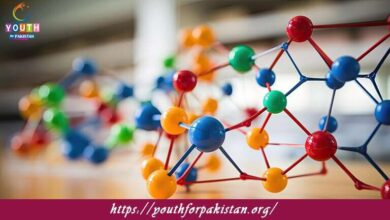12th Class Chemistry Chapter 16 MCQs with Answers

Deepen your knowledge of Environmental Chemistry with 12th Class Chemistry Chapter 16 MCQs. Topics include pollution, water treatment, and renewable energy. Keywords like environmental chemistry quiz, sustainability MCQs, and green chemistry prep ensure top-notch preparation.
Acid rain is caused by the presence of which pollutants in the atmosphere?
a) Carbon dioxide (CO2)
b) Sulfur dioxide (SO2) and nitrogen oxides (NOx)
c) Methane (CH4) and ozone (O3)
d) Particulate matter (PM10)
Which gas is the major component responsible for the greenhouse effect?
a) Oxygen (O2)
b) Carbon dioxide (CO2)
c) Nitrogen (N2)
d) Hydrogen (H2)
The ozone layer is located in which region of the atmosphere?
a) Troposphere
b) Mesosphere
c) Stratosphere
d) Thermosphere
Ozone depletion is mainly caused by:
a) Sulfur dioxide (SO2) emissions
b) Nitrogen oxides (NOx) emissions
c) Chlorofluorocarbons (CFCs) and other halocarbons
d) Carbon dioxide (CO2) emissions
Which international agreement aimed to phase out the production and consumption of ozone-depleting substances?
a) Montreal Protocol
b) Kyoto Protocol
c) Paris Agreement
d) Basel Convention
Which of the following is a primary air pollutant?
a) Ground-level ozone (O3)
b) Particulate matter (PM10)
c) Sulfuric acid (H2SO4)
d) Nitric oxide (NO)
1
The “Great Smog” of 1952 in London was primarily caused by:
a) Carbon dioxide (CO2) emissions
b) Methane (CH4) emissions
c) Sulfur dioxide (SO2) emissions
d) Nitrogen oxides (NOx) emissions
Which of the following air pollutants is a product of incomplete combustion of fossil fuels?
a) Sulfur dioxide (SO2)
b) Carbon monoxide (CO)
c) Nitrogen oxides (NOx)
d) Methane (CH4)
The process of converting nitrogen oxides (NOx) and volatile organic compounds (VOCs)
in the presence of sunlight into ground-level ozone (O3) is known as:
a) Acidification
b) Photochemical smog formation
c) Eutrophication
d) Greenhouse effect
What is the primary source of anthropogenic carbon dioxide (CO2) emissions?
a) Transportation
b) Agriculture
c) Deforestation
d) Industrial processes
The “Dead Zone” in the Gulf of Mexico is caused by:
a) Oil spills
b) Eutrophication
c) Radioactive waste dumping
d) Plastic pollution
Which of the following is NOT a greenhouse gas?
a) Carbon dioxide (CO2)
b) Methane (CH4)
c) Nitrous oxide (N2O)
d) Sulfur dioxide (SO2)
The term “eutrophication” refers to:
a) The accumulation of toxic substances in the food chain
b) The depletion of the ozone layer
c) The excessive growth of algae in water bodies
d) The formation of acid rain
Which of the following pollutants is a major cause of indoor air pollution?
a) Carbon monoxide (CO)
b) Ground-level ozone (O3)
c) Sulfur dioxide (SO2)
d) Nitrogen oxides (NOx)
The process of converting nitrogen oxides (NOx) and sulfur dioxide (SO2) into nitric acid
(HNO3) and sulfuric acid (H2SO4), respectively, is known as:
a) Photochemical smog formation
b) Acid rain formation
c) Greenhouse effect
d) Ozone depletion
The “ozone hole” is most pronounced over which region?
a) Antarctica
b) Arctic
c) North America
d) Europe
Volatile organic compounds (VOCs) are precursors to the formation of:
a) Ground-level ozone (O3)
b) Acid rain
c) Particulate matter (PM10)
d) Nitric oxide (NO)
The process of converting nitric oxide (NO) into nitrogen dioxide (NO2) in the atmosphere is known as:
a) Volcanic activity
b) Nitrogen fixation
c) Nitrogen deposition
d) Photochemical oxidation
The combustion of fossil fuels releases which greenhouse gas into the atmosphere?
a) Methane (CH4)
b) Carbon dioxide (CO2)
c) Nitrous oxide (N2O)
d) Water vapor (H2O)
The “Minamata disease” was caused by the release of which toxic metal into the water
bodies?
a) Lead
b) Mercury
c) Cadmium
d) Chromium
The process of converting nitrogen oxides (NOx) into nitric acid (HNO3) is a major contributor to:
a) Greenhouse effect
b) Ozone depletion
c) Acid rain
d) Photochemical smog formation
The “Cuyahoga River fire” in 1969 was a significant event that raised awareness about:
a) Oil spills
b) Acid rain
c) Water pollution
d) Air pollution
Which of the following is a secondary air pollutant formed through the reaction of nitrogen oxides (NOx) and volatile organic compounds (VOCs) in the presence of sunlight?
a) Particulate matter (PM10)
b) Carbon monoxide (CO)
c) Ground-level ozone (O3)
d) Sulfur dioxide (SO2)
The process of converting sulfur dioxide (SO2) into sulfuric acid (H2SO4) in the atmosphere is a major contributor to:
a) Acid rain
b) Photochemical smog formation
c) Greenhouse effect
d) Ozone depletion
The “Great Pacific Garbage Patch” is an example of:
a) Air pollution
b) Soil pollution
c) Water pollution
d) Noise pollution
The process of converting carbon dioxide (CO2) into carbonic acid (H2CO3) in the atmosphere is a major contributor to:
a) Acid rain
b) Greenhouse effect
c) Ozone depletion
d) Photochemical smog formation
The accumulation of persistent organic pollutants (POPs) in the food chain is known as:
a) Acidification
b) Eutrophication
c) Biomagnification
d) Greenhouse effect
The process of converting nitrogen oxides (NOx) and sulfur dioxide (SO2) into particulate matter in the atmosphere is known as:
a) Photochemical smog formation
b) Acid rain formation
c) Greenhouse effect
d) Volcanic activity
Which of the following is a major greenhouse gas produced by ruminant animals during digestion?
a) Methane (CH4)
b) Carbon dioxide (CO2)
c) Nitrous oxide (N2O)
d) Water vapor (H2O)
The “Kyoto Protocol” aimed to reduce emissions of greenhouse gases from industrialized
countries to combat:
a) Ozone depletion
b) Acid rain
c) Global warming
d) Water pollution
The process of converting ammonia (NH3) and ammonium compounds into nitric acid
(HNO3) in the atmosphere is a major contributor to:
a) Acid rain
b) Photochemical smog formation
c) Greenhouse effect
d) Ozone depletion
The phenomenon of temperature inversion contributes to the formation of:
a) Acid rain
b) Photochemical smog
c) Greenhouse effect
d) Ozone hole
Which of the following pollutants is known to cause respiratory and cardiovascular diseases in humans?
a) Particulate matter (PM10)
b) Carbon monoxide (CO)
c) Sulfur dioxide (SO2)
d) Nitrogen oxides (NOx)
The “Love Canal” incident in the 1970s brought attention to the issue of:
a) Acid rain
b) Water pollution
c) Radioactive waste disposal
d) Air pollution
The process of converting carbon monoxide (CO) into carbon dioxide (CO2) in the atmosphere is known as:
a) Volcanic activity
b) Methane oxidation
c) Greenhouse effect
d) Photochemical smog formation
The process of converting sulfur dioxide (SO2) into sulfate aerosols in the atmosphere can have a cooling effect on the climate and is known as:
a) Greenhouse effect
b) Ozone depletion
c) Acid rain
d) Global dimming
The “Bhopal disaster” in 1984 was caused by the release of which toxic gas?
a) Sulfur dioxide (SO2)
b) Nitrogen oxides (NOx)
c) Methyl isocyanate (MIC)
d) Carbon monoxide (CO)
Which of the following pollutants is a major component of photochemical smog?
a) Sulfur dioxide (SO2)
b) Carbon monoxide (CO)
c) Nitrogen oxides (NOx)
d) Methane (CH4)
The “Minamata Convention” aims to address the issue of mercury pollution in:
a) Air
b) Water
c) Soil
d) All of the above
The process of converting ammonia (NH3) and ammonium compounds into nitrogen oxides (NOx) in the atmosphere is a major contributor to:
a) Acid rain
b) Photochemical smog formation
c) Greenhouse effect
d) Ozone depletion
The “Deepwater Horizon” oil spill in 2010 had a significant impact on which marine
ecosystem?
a) Great Barrier Reef
b) Gulf of Mexico
c) Mediterranean Sea
d) Baltic Sea
The process of converting volatile organic compounds (VOCs) and nitrogen oxides (NOx)
into ground-level ozone (O3) is known as:
a) Acid rain formation
b) Greenhouse effect
c) Photochemical smog formation
d) Ozone depletion
Which of the following is a major contributor to indoor air pollution in homes and buildings?
a) Sulfur dioxide (SO2)
b) Carbon monoxide (CO)
c) Nitrogen oxides (NOx)
d) Methane (CH4)
The process of converting methane (CH4) into carbon dioxide (CO2) in the atmosphere is known as:
a) Volcanic activity
b) Methane oxidation
c) Greenhouse effect
d) Photochemical smog formation
The process of converting sulfur dioxide (SO2) into sulfuric acid (H2SO4) in the atmosphere is a major contributor to:
a) Acid rain
b) Photochemical smog formation
c) Greenhouse effect
d) Ozone depletion
The “Fukushima Daiichi” nuclear disaster in 2011 resulted from a:
a) Nuclear explosion
b) Meltdown of nuclear reactors
c) Oil spill
d) Radiation leak from a research facility
Which of the following pollutants is a major component of smog and is responsible for reducing visibility in urban areas?
a) Sulfur dioxide (SO2)
b) Carbon monoxide (CO)
c) Nitrogen oxides (NOx)
d) Particulate matter (PM10)
The process of converting nitrogen oxides (NOx) into nitric acid (HNO3) is a major contributor to:
a) Acid rain
b) Photochemical smog formation
c) Greenhouse effect
d) Ozone depletion
The “Chernobyl disaster” in 1986 was caused by a:
a) Nuclear explosion
b) Meltdown of nuclear reactors
c) Oil spill
d) Radiation leak from a research facility
The process of converting methane (CH4) and carbon monoxide (CO) into carbon dioxide
(CO2) in the atmosphere is known as:
a) Methane oxidation
b) Greenhouse effect
c) Photochemical smog formation
d) Acid rain formation
The “Exxon Valdez” oil spill in 1989 had a significant impact on which marine ecosystem?
a) Great Barrier Reef
b) Gulf of Mexico
c) Mediterranean Sea
d) Prince William Sound, Alaska
The process of converting volatile organic compounds (VOCs) and nitrogen oxides (NOx)
into ground-level ozone (O3) is known as:
a) Acid rain formation
b) Greenhouse effect
c) Photochemical smog formation
d) Ozone depletion
Which of the following pollutants is a major contributor to indoor air pollution in homes and buildings?
a) Sulfur dioxide (SO2)
b) Carbon monoxide (CO)
c) Nitrogen oxides (NOx)
d) Methane (CH4)
The process of converting methane (CH4) into carbon dioxide (CO2) in the atmosphere is known as:
a) Volcanic activity
b) Methane oxidation
c) Greenhouse effect
d) Photochemical smog formation
The process of converting sulfur dioxide (SO2) into sulfuric acid (H2SO4) in the atmosphere is a major contributor to:
a) Acid rain
b) Photochemical smog formation
c) Greenhouse effect
d) Ozone depletion
The “Fukushima Daiichi” nuclear disaster in 2011 resulted from a:
a) Nuclear explosion
b) Meltdown of nuclear reactors
c) Oil spill
d) Radiation leak from a research facility
Which of the following pollutants is a major component of smog and is responsible for reducing visibility in urban areas?
a) Sulfur dioxide (SO2)
b) Carbon monoxide (CO)
c) Nitrogen oxides (NOx)
d) Particulate matter (PM10)
The process of converting nitrogen oxides (NOx) into nitric acid (HNO3) is a major contributor to:
a) Acid rain
b) Photochemical smog formation
c) Greenhouse effect
d) Ozone depletion
The “Chernobyl disaster” in 1986 was caused by a:
a) Nuclear explosion
b) Meltdown of nuclear reactors
c) Oil spill
d) Radiation leak from a research facility
The process of converting methane (CH4) and carbon monoxide (CO) into carbon dioxide
(CO2) in the atmosphere is known as:
a) Methane oxidation
b) Greenhouse effect
c) Photochemical smog formation
d) Acid rain formation
If you are interested to enhance your knowledge regarding Physics, Chemistry, Biology, and Computer please click on the link of each category, you will be redirected to dedicated website for each category.





